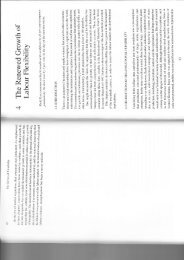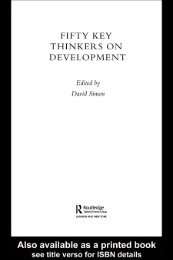GLOBALISATION AND THE THIRD WORLD.pdf - Steerweb.org
GLOBALISATION AND THE THIRD WORLD.pdf - Steerweb.org
GLOBALISATION AND THE THIRD WORLD.pdf - Steerweb.org
Create successful ePaper yourself
Turn your PDF publications into a flip-book with our unique Google optimized e-Paper software.
<strong>GLOBALISATION</strong> <strong>AND</strong> <strong>THE</strong> <strong>THIRD</strong> <strong>WORLD</strong>http://pubs.socialistreviewindex.<strong>org</strong>.uk/isj81/marfleet.htm9 of 25 16/03/2012 21:46Global capitalForms of capital: The theory of combined and uneven development provides a framework forunderstanding the pattern of world development. But just as Trotsky relied upon Marx's economic theoriesto explain the dynamics of Russian capitalism, so it is necessary to mobilise Marx's approach tounderstand recent developments in the world economy, especially the increased inequalities between theWest and the Third World, and within Third World societies, that the globalist account conceals.Marx's approach to the circulation of capital is vital to this task, especially because of the globalisers'insistence that capital flows are the key element in making a more equitable world. In classical economicsand its contemporary variant, neo-liberalism, capital is essentially unitary, expressing itself as money,investment or profit and growing by virtue of entrepreneurs' energy in exploiting opportunities offered bythe marketplace. In the globalist perspective, capital flows worldwide as the result of direct investment bycompanies and individual entrepreneurs, of activity on stockmarkets and commodity exchanges, and ofinitiatives taken by banks and finance houses. It is the change in volume and speed of capital transfersthat makes for the more even distribution of capital and hence for globalisation.Marx argued that capital can take different forms. He suggested that capital is not unitary, nor does itexpand 'naturally' through the alchemy of the market. Rather, as he explained in Volume 2 of Capital, itsform depends upon the human relationships involved in its mobilisation. Thus money and commoditycapital are expressions of capital in circulation. Each, however, has its origins in productive capital, thatwhich results from the direct exploitation of human labour. As Chris Harman insists, 'The point isimportant--money-capital often seems to be the "pure" form of capital, the form in which the selfexpansion of value is most vividly to be seen. But like the other forms of capital, it is in reality, as Marxput it, "not a thing but a relation", a relation which involves the exploitation of people at the point ofproduction'. 62Identification of different forms of capital does not mean that they exist wholly independently: the processof accumulation involves many changes from one form to another. Production, which is at the core of thecapitalist economy, requires that money-capital is used to buy machinery, materials and labour; andproduction itself brings into being commodities, which are in turn exchanged for money. But money canbe moved through the system far more quickly than capital in form of material objects--machines,production lines, transport systems, etc. This is especially important in the context of credit. Banks andfinance houses have emerged through the efforts of capitalists to benefit from situations in which theyhave profit to invest--but not necessarily enough to invest immediately in productive projects such as newfactories or machinery. They may therefore lend what they have in hand to other capitalists, usuallythrough banks. When they need to mobilise large sums they apply to banks for loans. In effect, the loan isan advance to the capitalist on the expectation of later realisation of surplus value through directexploitation. It is in this context that speculation takes place, as capitalists gamble on anticipated profits,often using credit, and hoping to drive up prices in the process.The distinction between forms of capital is of special significance in periods of slump. Faced with thisprospect some capitalists may mobilise more of their resources in the form of money or commoditycapital. This must be moved through financial networks based on banks, stockmarkets or commodityexchanges but does not require the relatively complex and stable sets of relationships associated withproductive capital. Above all, it does not require the elaborate social and political systems within whichaccumulation of surplus value from human labour is accomplished. This helps to explain why a worldeconomy which, at one level, is integrated by movements of money, becomes increasingly prone todestabilisation. It also explains the glaring contradictions associated with general movements of capital:how at one level such movements may prompt integration but at another level may have the effect ofintensifying unevenness within the world system.Financial capital: Even orthodox economists have recently become alarmed by the disproportionbetween what they call the 'paper' economy--debt--and 'fundamentals' such as growth in output. Druckerwarns, 'Ninety percent or more of the transnational economy's financial transactions do not serve what




